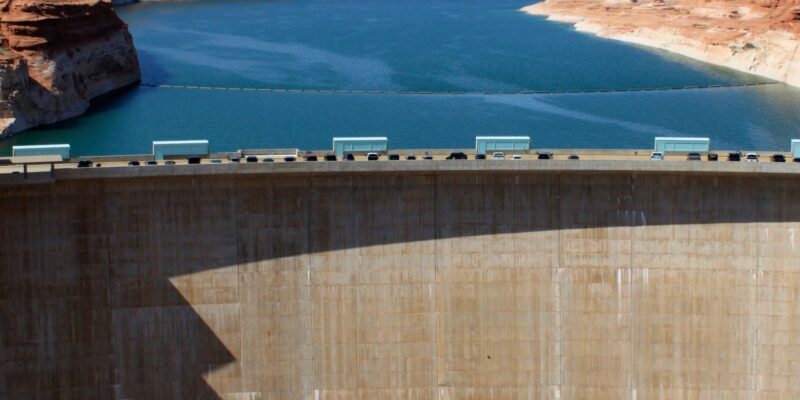
The water level at Lake Powell, the massive reservoir on the Colorado River whose southern reaches straddle the Utah-Arizona border, hit a record low this week, sinking to just 3,522 feet above sea level. A 23-year megadrought combined with climate change has left the reservoir at just 22 percent of its capacity—so low that it threatens to cause the collapse of a water supply system serving 40 million people throughout the arid west.
Created by the 1963 construction of the Glen Canyon Dam, Lake Powell is the nation’s second-largest reservoir. Over the past year, federal officials have ordered emergency water releases from upstream reservoirs, such as Utah’s Flaming Gorge, to prop up the lake and keep the dam’s turbines turning and providing electricity. While this year’s above average snowpack may help, even the Bureau of Reclamation, which historically has wildly overestimated the Colorado River’s flow, expects Lake Powell to drop another 30 feet by September.
One underappreciated element of this looming crisis is Glen Canyon Dam itself. If the water level in Lake Powell falls another 150 feet from its current level, the reservoir will hit dead pool, meaning that the Colorado River will no longer run through the dam, stopping flow to booming populations in Arizona and Nevada, as well as to Mexico and the agricultural areas of California’s Imperial Valley.
“Lake Powell is quickly approaching the point at which it may soon become physically impossible to pass enough water through the dam,” warned an August report by regional environmental groups. “Such an event would likely be the most calamitous in the Colorado River System’s history, causing legal complications, economic harm, and a water supply crisis across the seven states and Mexico.”
Environmentalists have long hated the Glen Canyon Dam, which submerged beautiful canyons, caused environmental degradation, and harmed endangered fish in the Grand Canyon. Edward Abbey’s landmark novel The Monkey Wrench Gang was based on a plot to blow up the structure.
At this point, blowing up the dam might not be such a bad idea. Scientists have known for a long time that the dam is obsolete. With its antique and poorly-designed plumbing, the dam simply won’t function if the water behind it drops below 240 feet. Such a scenario would leave nearly 2 million acre-feet of stagnant river water stranded behind the dam, unable to reach the lower watershed.
The Bureau of Reclamation, which regulates water delivery from the Colorado River, recently proposed a new plan to keep water flowing around the dam: tunnels. But the proposal is expensive, complicated, and time consuming. John Weisheit, the founder of the Utah environmental group Living Rivers and an advocate for tearing down the dam, told the Los Angeles Times this week that the proposed modifications represented “too much investment for very little return. And it’s going to take a long, long time.”
But other water watchers are more optimistic. As Gary Wockner, director of Save the Colorado, said in a press release after viewing the Bureau’s presentation on the dam, “We’re pleased to see the federal government proposing to bypass Glen Canyon Dam with tunnels. For years, we’ve pointed out that much of the Colorado River ‘crisis’ has been caused by the mere existence of Glen Canyon Dam, and that bypassing or removing the Dam should be an obvious alternative under consideration.”















